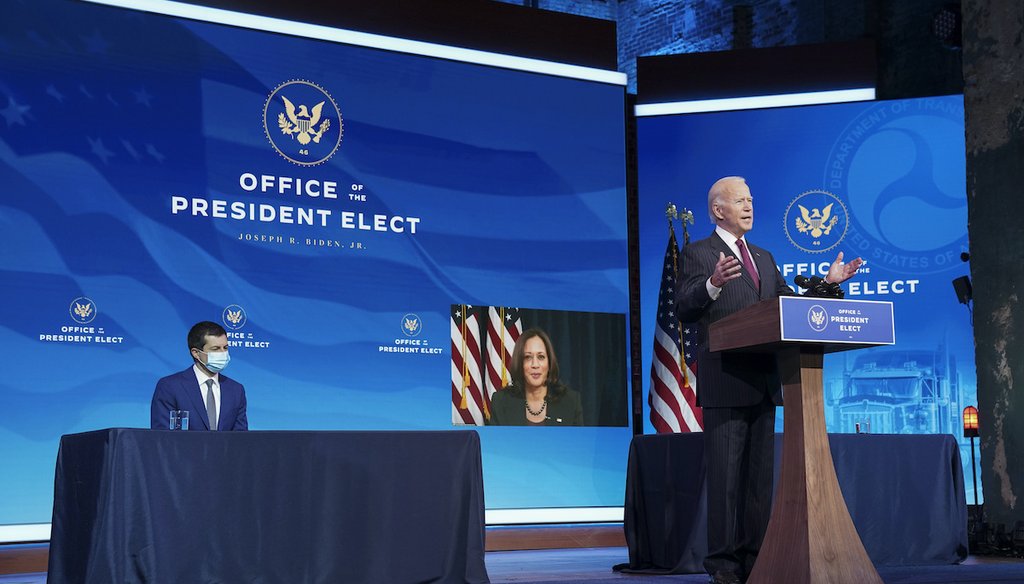



President-elect Joe Biden announces former South Bend, Ind. Mayor Pete Buttigieg as his nominee for transportation secretary during a news conference at The Queen theater in Wilmington, Del., Wednesday, Dec. 16, 2020. (AP)
At least 46,000 bridges are rated structurally deficient.
About 20% of them are in high-use urban areas.
As a rule, well before bridges face the risk of imminent collapse, transportation officials shut them down.
Democrats have argued for decades that jobs, economic growth and progress on climate change all meet at the Transportation Department. As he announced his transportation secretary nominee Pete Buttigieg, President-elect Joe Biden hit each of those points, plus the simple need for safety.
"Tens and tens of thousands of bridges are in disrepair, some on the verge of collapse, presenting a clear and present danger to people’s lives," Biden said Dec. 16.
Bipartisan efforts to deal with the nation’s aging infrastructure are a fairly regular occurrence, and for good reason. Over 40% of bridges are at least 50 years old. State and local governments repair them regularly, but Biden’s words focused on the work that remains.
Based on government numbers, Biden described the challenge fairly accurately, although experts told us his words about the immediate risk are overblown. Bridges are generally closed before they reach the stage where a collapse is imminent.
A construction trade group, the American Road and Transportation Builders Association, reported that over 46,000 bridges meet the definition of "structurally deficient." In layman’s terms, that means key parts of those bridges, perhaps steel struts or concrete supports, are rusting, cracked or otherwise in poor shape. Such bridges must be inspected every year, and engineers know that they need significant work, if not total replacement.
There are different ways to calculate the number of structurally deficient bridges. The Congressional Research Service said there were 56,000 in 2016, representing about 9% of the total. The transportation builders use a lower number, with data current through 2019. That group estimates about 7.5% of the nation’s total fall into the worst category.
The danger of crumbling bridges is real, and it’s not limited to the most deteriorated ones. A chunk of concrete from a bridge in Michigan injured a woman in February 2020 as she drove under it. The bridge was rated as being in "fair" condition, a notch below "good", and a notch above "poor." A state official told the local newspaper it was "not the worst bridge out there."
If Biden’s comment about the number of bridges in the worst shape is on the money, his warning about bridges "on the verge of collapse" is overly dire.
"There are no bridges in the U.S. that are open that are in danger of imminent collapse," said the American Society of Civil Engineers’ Maria Lehman.
The operative word is "open." While hidden design flaws, such as the one behind a 2007 fatal bridge collapse in Minneapolis, might be out there, inspection data does not show that motorists are driving over bridges that could crumble beneath them.
Under federal guidelines, state inspectors rate bridges on a 0 to 9 scale, with zero being "failed condition" and 9 being "excellent condition."
"At a 3 (serious condition), generally bridges are closed," Lehman said.
Chung C. Fu, director of the University of Maryland’s Bridge Engineering Software and Technology Center, amplified that point.
"If the rating drops to 2 or less, the bridge is long since closed," Fu said.
Bridges vary greatly. The Congressional Research Service noted that about 80% of structurally deficient bridges are in rural areas.
"These bridges tend to be small and relatively lightly traveled," they wrote.
The transportation builders group estimates it would cost $164 billion to bring every bridge up to snuff. As a fraction of each state’s inventory, Rhode Island, West Virginia and Iowa have the greatest need, with about one out of five bridges deemed structurally deficient.
There is some good news. Over the years, the fraction of bridges in poor shape has gone down, from nearly 11% in 2004 to just over 7% in 2019. Federal spending to repair them was as high as $9 billion in 2009 under the Great Recession recovery package. Since then, it has hovered around $6 billion.
Biden said there are "tens and tens of thousands" of bridges in disrepair, and some are on the verge of collapse.
At least 46,000 bridges are rated to be in the worst shape. Most are in rural areas and are lightly used. Contrary to Biden’s dire description, engineering experts told us that no one is driving over bridges that could come down at any moment. Random events and human error aside, transportation officials close bridges before they reach that point.
The accuracy of Biden’s words is mixed. We rate this claim Half True.
Joe Biden, Transportation secretary announcement, Dec. 16, 2020
Federal Highway Administration, Bridge Condition by Highway System, Dec. 31, 2019
Federal Highway Administration, Frequently Requested NBI Information, May 8, 2020
American Society of Civil Engineers, Infrastructure report card: Bridges, 2017
Lansing State Journal, Woman injured after concrete from bridge above U.S. 127 breaks off, goes through car's windshield, Feb. 20, 2020
American Road and Transportation Builders Association, 230,000 U.S. Bridges Need Repair, April 12, 2020
Federal Highway Administration, Status of the Nation's Highways, Bridges, and Transit, Oct. 22, 2020
National Transportation Safety Board, Collapse of I-35W Highway Bridge Minneapolis, Minnesota, Nov. 14, 2008
Congressional Research Service, Highway Bridge Conditions: Issues for Congress, Jan. 17, 2018
Email exchange, Chung C. Fu, director, Bridge Engineering Software and Technology Center, University of Maryland School of Engineering
Email exchange, Press office, American Society of Civil Engineers, Dec. 17, 2020
In a world of wild talk and fake news, help us stand up for the facts.
